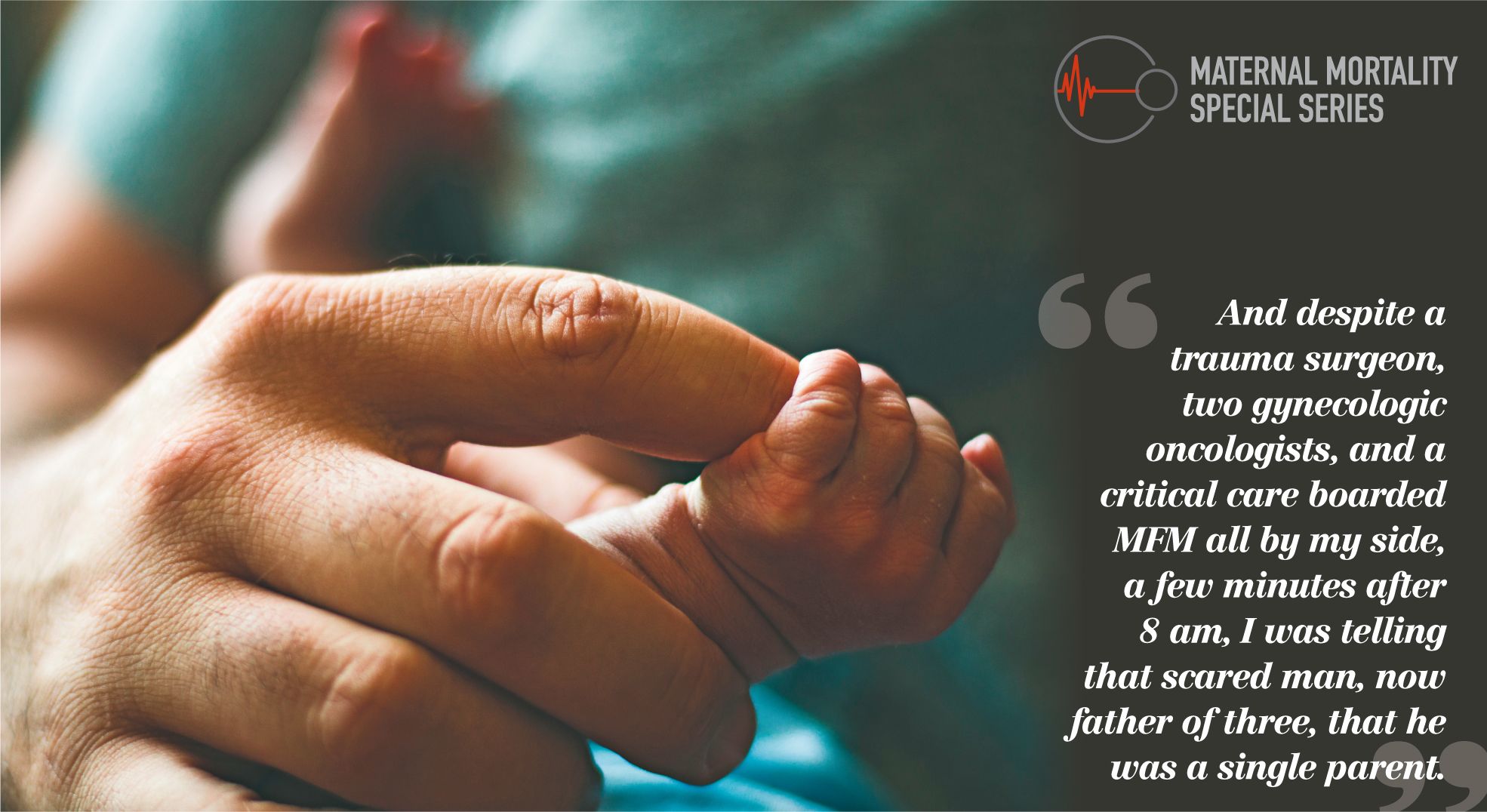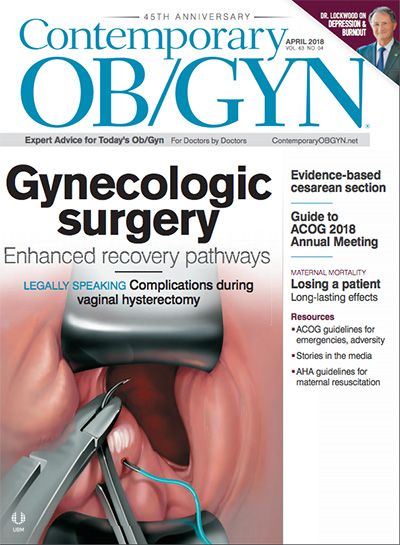Memorials to two mothers
Two physicians recount their experiences of losing a patient.

As obstetricians we commit ourselves to a job that consists mostly of bringing life to the world. These celebrations offer such joy in our work. Less often we are shepherds of loss. We help a couple through miscarriage or stillbirth and support families with the loss of a newborn, for example. These moments are most devastating for patients and their families, but they are also full of grief for us. We are never prepared for, nor do we completely recover from, the loss of a mother. Mothers are young. Mothers are the foundations of a family. Most of the time, the loss of a mother is sudden and unexpected. It leaves an empty space unlike any other. Most obstetricians can recite the names of every mother we helped take care of, but lost.
We offer these two memorials as part of Contemporary OB/GYN’s maternal mortality series and to share our experiences. When we were asked to write, we accepted without a second thought; it is easy to write about people we think about on most days. We hope that reflecting on these lives and how we have been changed by them can help our colleagues reflect on their own experiences. We also aim to help motivate a movement to improve efforts to prevent maternal mortality. Our reflection on these cases cannot dwell purely on the profound sadness of it all or how we might have wanted it to go differently. From each case we need to grow and change and get better for the next woman that comes through our door.
During a low point in training, during a time of loss, one of our mentors offered important words of encouragement in this context: “You will be changed by this event. You will either be better from it, or worse from it. But you are the one who chooses which it will be.” In trying to make things better, and in a spirit of fellowship for our colleagues reading this, we are sharing our stories.
Sunrises
by Erika Werner, MD, MS

We paused in the hallway halfway between triage and the operating room (OR), so she could kiss her kids. “We will take good care of her,” I remember saying to the two scared, sleepy looking faces. They were in pajamas and attached to their dad. One was about a year younger than my daughter and one was about a year older.
“She lost a lot of blood,” her husband said again. I nodded, said “I know” and tried to sound reassuring. “We have blood on the way, but the most important thing right now is that we get her into the operating room.” And off we went. It was 5:45 am.
By the time the case started, I had two chiefs operating with me. Thank goodness for change of shift. We worked quickly to get in, acutely aware of how quickly blood was coming out from below. The woman was scheduled to be seen for the first time the next day by maternal-fetal medicine (MFM), but I knew at minimum she had a bleeding previa and two prior cesareans. Anesthesia was transfusing, the cell saver was being assembled, oncology was on their way, my back-up was coming. I was supported. This was the way it was supposed to work.
Yet despite my amazing team, a very prepared hospital, and my years of training, 90 minutes later I was giving chest compressions. And despite a trauma surgeon, two gynecologic oncologists, and a critical care boarded MFM all by my side, a few minutes after 8 am, I was telling that scared man, now father of three, that he was a single parent.
Six hours later, after debriefing with the many residents, nurses, and specialists who shared in this tragedy with me, I was back home. My family was the same, my house was the same, but nothing would ever be quite the same. I took a healthy young woman into the OR to deliver her baby and she died on my OR table in my care.
As I learned more about my patient in the days that followed her death, from the neonatal intensive care unit doctors who took care of her 32-weeker, from hospital staff who knew her as a friend, and from her family who spoke at her funeral, I was bothered most by the fact that we did not have the chance to know one another. I hated that our entire patient-doctor relationship was defined by that night. I wanted her to know the kind of doctor I was. I wanted the opportunity to answer her questions and concerns. I wanted to reassure her that even in the brief moments we had together, I understood how much she loved her children, and I would have done anything to have her case end differently. I wanted then and now to be able to reach out to her family, to see her kids, to tell them in person how sorry I was. And yet because of the Health Insurance Portability and Accountability Act, the medical legal system, and perhaps most importantly because of a brief moment of eye contact between her husband and me at the funeral, I have stayed away. I am a caregiver but I continue to care in this instance in silence.
Now almost a decade out from this tragedy, I continue to think about this woman, her daughter, and her family almost every day. In the early years, what used to surprise me most was that I barely knew this woman or her family and yet I thought about them not only at work when I was counseling, operating, and teaching, but at home when I was tucking my kids in, laughing with my husband, or admiring a sunrise. As the years have passed, I have become more comfortable with how frequently my thoughts drift to her and her family. Her story has become part of my story even though our endings were so different.
For my part, I have been exceptionally lucky. This tragedy could have led to self-doubt and a disdain for the uncertainty and powerlessness of obstetrical care. Perhaps because of the amazing team who got me through that night, I continue to believe that I kept my promise and that we took good care of this mom. I continue to love obstetrics, especially the most challenging deliveries, which push us all to be better. I will forever feel vulnerable because of that night, but I feel honored to be with families at these most dangerous and intimate moments.
Getting Better
by Christian M. Pettker, MD

She came to our practice after finding out the worst and best information a woman can hear. A neurologist told her the bad news that she had suspected: Her symptoms indeed were signs that the disease that took her mother would also slowly but soon take her life, too. At the same time, she found out she was pregnant. The neurologist and our MFM team were uncertain if she would live through her pregnancy. She was certain she would try. She wanted to be a mother, she wanted her husband to be a father, and she wanted to give life to her child.
With her first visit to our practice she set into motion a transformation of our service. We spent weeks coordinating her care and planning her admission. We assembled all of the specialists and all of the nursing units for regularly scheduled morning meetings planning for her pregnancy. At a certain point she and her husband wanted to join the meetings. Despite our trepidation at this request, based on a paternalistic fear that we would have trouble discussing openly some of the scarier parts of her care, we accepted this challenge. And together we planned for the joy of birth but also for all of the frightening moments she might encounter to get there.
We took care of the woman for four months in the hospital-she was in the ICU all of those days-progressively losing her strength to move, talk, and breathe. With each week we added another specialty to our meetings, to support her feeding or to plan her tracheostomy and ventilator management. But at the same time, we tried to commit to all of the normal aspects of childbirth, too. Our lactation team visited her in the third trimester to discuss her plans for breastfeeding. The labor and maternity nurses threw her a baby shower in the intensive care unit. One of my highest honors as an obstetrician was to be invited; it remains, and will probably always be, the only baby shower I have attended. She was committed to becoming well again and having as normal an experience as possible. She believed there would be a cure for her disease in her lifetime.
Her plan was for a vaginal birth and despite her weakness we believed it was medically possible. At term, when we found out that her baby was in breech presentation, she requested an external cephalic version. We tried, but failed, and she ended up with a cesarean that included skin-to-skin, breastfeeding, and rooming-in, even in the ICU. She left the hospital with her husband and her baby, to go live and die at home.
She was able to see her child’s first birthday. As a result, she avoided becoming a “maternal mortality” “pregnancy-related death” statistic. Admittedly, when we talk about efforts to reduce maternal mortality we are not talking about preventing cases like this. But despite all we were able to do for her, those who took care of this family experienced profound loss because she did not live long enough. For me and my colleagues, years later even, this still has all of the sadness of a maternal loss.
All the way through the end, she felt blessed and had no regrets. I think she knew how much she touched and influenced each of her caregivers. Her courage and strength were something that built strength in our hospital’s service and made us so much better at taking care of complicated patients. Our introspection on her care and her life was important for our thinking about how to build a patient-centered destination hospital for the highest-risk pregnancies. Realizing how often complex patients at our hospital could be helped by this level of coordination, this work became a regularly occurring meeting that continues monthly to this day. What she started for us continues to amaze me. New specialties join our meetings all the time, though this is hardly challenging in a tertiary care center. It is when a family member, a church leader, an attorney, a conservator, or a patient joins us for these meetings that I am convinced we would not be meeting our patients’ true needs if our patient had not blessed us with her experience.
I think about her regularly. Certainly, each meeting of the Proactive Care group generates memories of our first meetings working together. But I also think about her every time I work harder to support a vaginal birth or the breastfeeding goals of a woman who faces smaller but still important challenges related to her medical problems or social issues. Most of all, I think of her strength and courage and her commitment to getting better in the face of her inevitable death. This makes me stronger, too.


